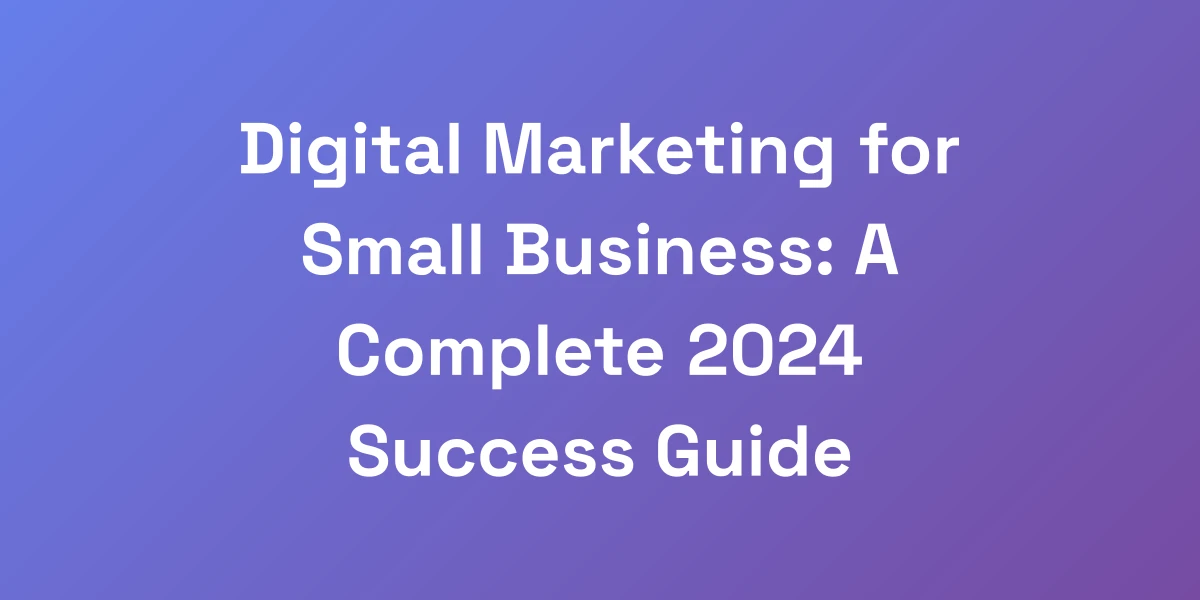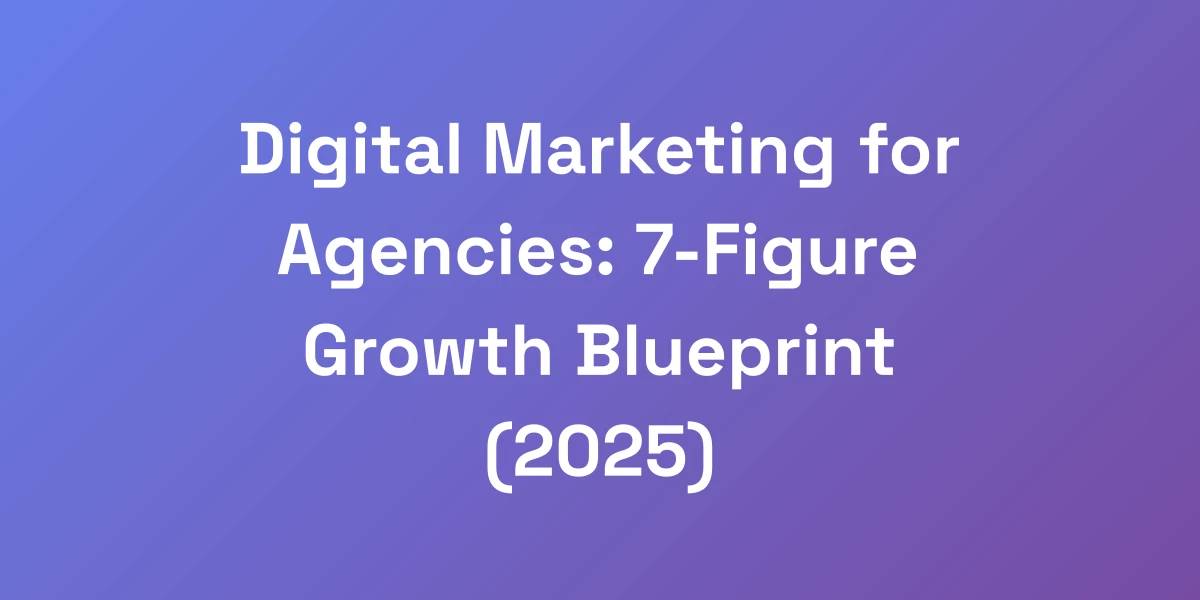
Digital Marketing for Startups: A Zero-BS Guide That Actually Works
Mar 1, 2025 | By [email protected]
Introduction
Let’s face it, navigating the world of digital marketing for startups can feel like trying to find your way out of a maze blindfolded.
Everywhere you look, there’s a new strategy, tool, or “secret hack” promising overnight success. But here’s the kicker: most of it is absolute BS.
We’ve seen numerous founders drain their budgets on flashy agencies and trendy growth hacks that lead to dead ends.
What if there was a straightforward, no-nonsense approach that actually delivers results?
In this guide, we’re cutting through the fluff and sharing the battle-tested tactics that helped our startup rake in $2M in revenue with just a $5K marketing spend.
No fluff, no theory – just real, actionable strategies tailored for 2025 and beyond.
Why Most Startup Marketing Strategies Fail (And What Actually Works)
Let’s cut to the chase: 90% of startup marketing advice is pure garbage.
We’ve witnessed countless startups fumble their runway on expensive agencies and ephemeral “growth hacks” that lead nowhere.
The truth? Successful digital marketing for startups isn’t about throwing money at every shiny object – it’s about being strategically scrappy.
So, what’s the difference between the startups that thrive and those that flop?
It’s all about having a solid foundation and smart, focused strategies. Let’s dive in.
The Traditional Marketing Playbook (And Why It’s Dead)
Traditional marketing methods might have worked in the past, but in today’s fast-paced digital landscape, they’re obsolete.
Think TV ads and billboards – sure, they have their place, but they’re not the lifelines for startups today.
Why? Because they’re expensive, hard to measure, and often miss the mark with your target audience.
Startups need agile, data-driven approaches that adapt quickly to market changes.
Sticking to outdated methods can drain your budget without delivering the desired results.
The New Rules of Startup Marketing
So, what are the new rules? It’s all about leveraging digital channels that offer measurable results and scalable growth.
Here’s a quick rundown:
- Focus on Digital Channels: Social media, SEO, and content marketing are your best friends.
- Data-Driven Decisions: Use analytics to guide your strategy and tweak it based on performance.
- Customer-Centric Approach: Understand your audience’s needs and tailor your message accordingly.
- Lean and Agile: Be ready to pivot your strategy based on what the data tells you.
These principles ensure that every dollar spent is an investment in growth, not a shot in the dark.
Case Study: How We Generated 100K Users Without Paid Ads
Let’s get real with a success story. Our startup managed to amass 100K users without spending a dime on paid ads.
How? By harnessing the power of organic channels and smart content strategies.
Here’s the breakdown:
- Content Marketing: We focused on creating high-quality, valuable content that resonated with our target audience.
- SEO Optimization: By using automated SEO optimization, we ensured that potential users could easily find us.
- Community Engagement: We actively engaged with our audience on social platforms, fostering a loyal community.
- Referral Programs: Encouraging our users to refer others helped us grow organically.
This approach not only saved us money but also built a strong, engaged user base that continues to support our growth.
Setting Up Your Marketing Foundation Right
Before you can scale, you need a solid marketing foundation. Here’s how to set it up:
- Define Your Brand: Clearly articulate your brand’s mission, values, and unique selling propositions.
- Understand Your Audience: Conduct thorough market research to identify your target customers and their pain points.
- Build a User-Friendly Website: Your website is often the first impression – make it count.
- Implement Analytics: Tools like Google Analytics are essential for tracking your marketing efforts and making data-driven decisions.
A strong foundation ensures that your marketing efforts are aligned with your business goals and can be effectively scaled as you grow.
The Only 3 Marketing Channels That Matter for Early-Stage Startups
Listen up: your startup doesn’t need to be everywhere. You need to dominate exactly three channels that give you the biggest bang for your buck.
We learned this the hard way after wasting months trying to maintain a presence across a dozen platforms.
The secret sauce? Pick channels where your target customers actually hang out, not where marketing gurus tell you to be.
Here’s the brutal truth about which channels actually move the needle for early-stage startups in 2025.
Channel #1: Content Marketing That Actually Converts
Content marketing isn’t just about churning out blog posts – it’s about creating content that drives conversions.
Here’s how to do it right:
- Identify Your Audience’s Needs: What problems are they facing? How can your product solve them?
- Create Valuable Content: Write in-depth guides, case studies, and how-to articles that provide real value.
- Optimize for SEO: Use relevant keywords and AI SEO tools to rank higher in search results.
- Promote Your Content: Share your content across relevant channels to maximize reach.
Effective content marketing builds trust and authority, leading to higher conversion rates.
Channel #2: Strategic Social Media Presence
Social media isn’t about being on every platform – it’s about being strategic on the platforms where your audience spends their time.
Here’s how to make the most of it:
- Choose the Right Platforms: Focus on platforms where your audience is most active, whether that’s LinkedIn, Instagram, or Twitter.
- Engage Consistently: Regularly interact with your followers through posts, comments, and messages.
- Leverage Visual Content: Use images, videos, and infographics to make your content more engaging.
- Utilize Paid Social Carefully: When done right, social media ads can target your audience with precision.
A strategic social media presence fosters community and drives brand loyalty.
Channel #3: Email Marketing 2.0
Email marketing remains one of the most effective channels for startups, especially when done right.
Here’s how to elevate your email marketing game:
- Build a Quality Email List: Focus on attracting subscribers who are genuinely interested in your product.
- Personalize Your Emails: Tailor your messages based on user behavior and preferences.
- Automate Your Campaigns: Use tools like marketing automation tools to automate email sequences, ensuring timely and consistent communication.
- Analyze and Optimize: Regularly review your email performance and tweak your strategies based on data.
Email marketing 2.0 is all about delivering the right message to the right person at the right time.
How to Know Which Channel Works Best for You
Not sure which channels to focus on? Here’s a simple framework to help you decide:
- Define Your Goals: What do you want to achieve? Brand awareness, lead generation, sales?
- Analyze Your Audience: Where does your target audience spend their time?
- Evaluate Channel Strengths: Which channels align best with your goals and audience behaviors?
- Test and Iterate: Start small, measure results, and refine your strategy based on what works.
By systematically evaluating your options, you can focus your efforts on the channels that offer the highest ROI.
Resource Allocation Framework
Efficient resource allocation is crucial for maximizing your marketing efforts. Here’s a framework to get you started:
- Budget Allocation: Determine how much you can afford to spend on each channel, including affordable SEO for small businesses.
- Time Investment: Allocate your time based on the potential impact of each channel.
- Performance Metrics: Set clear KPIs to measure the success of each channel.
- Continuous Optimization: Regularly review your performance and reallocate resources to the best-performing channels.
This framework ensures that your resources are directed towards efforts that yield the highest returns.
The $500/Month Marketing Strategy That Drives 6-Figure Revenue
We’re about to reveal how to build a lean, mean marketing machine that costs less than your monthly coffee budget.
This isn’t about being cheap – it’s about being smart with limited resources.
The key is automation and leverage.
Here’s how to set up systems that generate leads while you sleep, using AI-powered auto SEO software.
This is the exact framework we used to scale three different startups.
The Essential Tech Stack Under $500
Building a cost-effective marketing tech stack is all about choosing tools that offer maximum functionality without draining your budget.
- Email Marketing: ActiveCampaign starts at $29/month, providing robust automation features.
- Social Media Management: Tools like Buffer or Hootsuite can help you schedule and manage posts efficiently.
- SEO Tools: Ahrefs or SEMrush offer comprehensive SEO analytics to optimize your content.
- Analytics: Google Analytics is free and essential for tracking website performance.
- Automation: Zapier allows you to automate workflows without coding, starting at $19.99/month.
These tools provide a solid foundation for executing effective marketing strategies without overspending.
Content Creation on a Shoestring Budget
Content is king, but creating high-quality content without a hefty budget is possible with the right approach.
- Repurpose Existing Content: Turn blog posts into videos, infographics, or social media snippets.
- User-Generated Content: Encourage your audience to create content related to your brand.
- Leverage Freelancers: Platforms like Upwork or Fiverr offer affordable content creation services.
- DIY Tools: Use tools like Canva for graphic design or Grammarly for writing assistance.
By being resourceful, you can maintain a consistent content output without breaking the bank.
Automation Workflows That Save Time
Automation is your best friend when it comes to scaling your marketing efforts efficiently.
- Email Sequences: Set up automated email sequences to nurture leads and onboard new users.
- Social Media Scheduling: Automate your social media posts to maintain a consistent presence.
- Lead Scoring: Use automation tools to score and prioritize leads based on their interactions.
- Customer Support: Implement chatbots to handle common inquiries, saving time for your support team.
These workflows ensure that your marketing machine runs smoothly, even with limited resources.
Growth Hacking vs. Sustainable Marketing
While growth hacking can offer quick wins, it’s not a long-term strategy.
Instead, focus on sustainable marketing practices that build lasting relationships and steady growth.
- Long-Term Content Strategy: Invest in content that remains relevant and continues to attract traffic over time.
- Customer Retention: Focus on keeping existing customers happy, as retaining a customer is cheaper than acquiring a new one.
- Consistent Branding: Maintain a consistent brand voice and message across all channels.
- Data-Driven Decisions: Use data to guide your strategies and continuously optimize for better results.
Sustainable marketing ensures that your growth is manageable and scalable.
ROI Tracking and Optimization
Tracking your ROI is essential to understand what’s working and where to allocate your resources.
- Set Clear KPIs: Define what success looks like for each campaign.
- Use AI tools for SEO like Google Analytics and ActiveCampaign can help you track performance.
- Regularly Review Metrics: Weekly or monthly reviews can help you identify trends and areas for improvement.
- Optimize Based on Data: Use the insights gained to tweak your strategies for better performance.
By continuously tracking and optimizing your efforts, you ensure that every dollar spent contributes to your growth.
Advanced Growth Tactics for Funded Startups
Once you’ve secured funding, the game changes – but that doesn’t mean you should start burning cash like a Silicon Valley cliché.
Here’s how to scale your marketing efforts intelligently without losing the scrappy mindset that got you here.
We’ll dive into advanced strategies that require more resources but deliver exponential returns when executed correctly.
These are the tactics that took us from 6 to 7 figures in revenue.
Scaling Content Operations
As your startup grows, so should your content efforts. Here’s how to scale effectively:
- Hire Specialized Content Creators: Bring on writers, designers, and video producers who can elevate your content quality.
- Implement a Content Management System: Streamline the content creation and publication process.
- Expand Content Types: Incorporate podcasts, webinars, and interactive content to diversify your offerings.
- Outsource Strategically: Use freelancers for overflow work to maintain flexibility.
Scaling your content operations ensures that you continue to engage and grow your audience effectively.
Paid Acquisition Strategies That Actually Work
When you have the budget, paid acquisition can significantly boost your growth. Here’s how to make it work:
- Targeted Ads: Use data to create highly targeted ad campaigns that reach your ideal customers.
- Retargeting: Re-engage visitors who didn’t convert the first time around.
- Multi-Channel Campaigns: Diversify your ad spend across platforms like Google Ads, Facebook, and LinkedIn for broader reach.
- A/B Testing: Continuously test different ad creatives and targeting options to optimize performance.
Effective paid acquisition strategies drive consistent and scalable growth.
Building a Growth Team
A dedicated growth team can spearhead your marketing efforts strategically. Here’s how to build one:
- Hire Diverse Talent: Include experts in SEO, content marketing, paid advertising, and data analysis.
- Foster Collaboration: Encourage cross-functional teamwork to generate innovative growth ideas.
- Set Clear Goals: Define specific, measurable objectives for your growth team.
- Invest in Training: Continuously upskill your team to keep up with the latest marketing trends and tools.
A strong growth team drives your marketing strategy forward and ensures that you stay ahead of the competition.
Advanced Analytics and Attribution
Understanding the full impact of your marketing efforts requires advanced analytics and accurate attribution.
- Implement Attribution Models: Use models like multi-touch attribution to understand how different channels contribute to conversions.
- Deep Dive into Data: Analyze user behavior and campaign performance to gain actionable insights.
- Utilize Predictive Analytics: Forecast future trends and adjust your strategies accordingly.
- Integrate Data Sources: Combine data from various platforms for a holistic view of your marketing performance.
Advanced analytics and attribution provide the insights needed to refine your marketing strategies and maximize ROI.
International Expansion Tactics
Scaling internationally can open up new markets and fuel exponential growth. Here’s how to approach it:
- Market Research: Understand the cultural nuances and market demands of your target regions.
- Localize Your Content: Translate and adapt your content to resonate with local audiences.
- Leverage Local Channels: Use marketing channels that are popular in the regions you’re targeting.
- Partnerships: Collaborate with local influencers and businesses to gain credibility and reach.
Smart international expansion tactics enable your startup to tap into new growth opportunities effectively.
Measuring Success: The Only Metrics That Matter
Stop obsessing over vanity metrics like page views and social media followers.
Focus on the numbers that actually impact your bottom line.
Here’s how to zero in on the metrics that matter.
The Critical KPIs for Startup Marketing
Identifying the right KPIs is crucial for tracking your marketing success.
- Customer Acquisition Cost (CAC): The cost to acquire a new customer.
- Lifetime Value (LTV): The total revenue a customer generates during their relationship with your business.
- Conversion Rate: The percentage of visitors who take a desired action.
- Return on Investment (ROI): The profitability of your marketing efforts.
- Churn Rate: The rate at which customers stop doing business with you.
These KPIs provide a clear picture of your marketing performance and guide your strategic decisions.
Setting Up Your Analytics Dashboard
An effective analytics dashboard is the backbone of your data-driven marketing strategy.
- Choose the Right Tools: Utilize tools like Google Analytics, SEMrush, and ActiveCampaign to gather data.
- Customize Your Dashboard: Tailor your dashboard to display the KPIs that matter most to your business.
- Automate Reporting: Set up automated reports to save time and ensure consistency.
- Make It Accessible: Ensure your team has easy access to the dashboard for real-time insights.
A well-set-up analytics dashboard allows you to monitor your performance seamlessly and make informed decisions swiftly.
A/B Testing Framework
A/B testing is essential for optimizing your marketing campaigns.
- Identify Variables to Test: Focus on elements like headlines, call-to-actions, and images.
- Create Test Variations: Develop different versions to see which performs better.
- Run Tests Simultaneously: Ensure that external factors don’t skew your results.
- Analyze Results: Determine which variation achieved better performance and implement the winning version.
With a robust A/B testing framework, you can continuously refine your marketing strategies for optimal results.
Monthly Reporting Template
Consistent reporting keeps your team aligned and accountable.
- Executive Summary: A brief overview of the month’s performance.
- Key Metrics: Detailed analysis of your critical KPIs.
- Campaign Performance: Insights into the effectiveness of your various campaigns.
- Action Items: Steps to take based on the data to improve future performance.
- Lessons Learned: What worked, what didn’t, and why.
A standardized monthly reporting template ensures that you stay on top of your marketing performance and make data-driven decisions.
Red Flags to Watch For
Knowing what to watch out for can save your startup from costly mistakes.
- Rising CAC: If your customer acquisition cost is increasing, it could indicate inefficiencies in your marketing strategy.
- Declining Conversion Rates: A drop in conversion rates may suggest issues with your website or marketing funnel.
- Low Engagement Rates: If your audience isn’t engaging with your content, it might not be relevant or valuable.
- High Churn Rate: A high churn rate indicates that customers aren’t finding long-term value in your product.
- Poor ROI: If your marketing efforts aren’t generating a positive return on investment, it’s time to reassess your strategies.
Being vigilant about these red flags allows you to make proactive adjustments and keep your marketing on track.
Conclusion
We’ve walked you through the no-BS approach to digital marketing for startups – from avoiding common pitfalls to leveraging the right channels and tools.
The key takeaway? It’s not about how much you spend, but how smart you spend it.
By focusing on strategic channels, building a solid marketing foundation, and continuously optimizing based on data, your startup can achieve remarkable growth without breaking the bank.
Now, it’s your turn to put these strategies into action.
Ready to transform your marketing efforts and drive real results?
Let’s get started! Share your thoughts and experiences in the comments below, and let’s build a community of smart, scrappy startups that actually make it.








